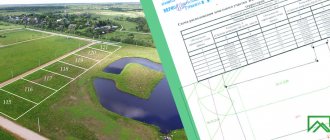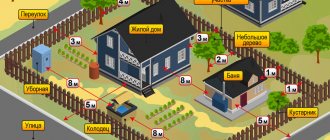Many land owners who leased it from the state later want to buy it for personal use; an integral part of this process is calculating the cost of the land. The formation of the price for a land plot largely depends on the method of its valuation; local authorities and the owner himself calculate the final amount using a special method.
Dear readers! Our articles talk about typical ways to resolve legal issues, but each case is unique. If you want to find out how to solve your particular problem, please use the online consultant form on the right or call. It's fast and free!
What is the redemption value of a land plot?
The redemption value of a plot is considered to be the price for the free transfer of land leased from the administration into ownership. In certain situations, it is used to buy out a plot of land from a citizen by local authorities. For example, when the state withdraws a site for its benefit for public needs or other activities of the region as a whole.
Sometimes you can come across another name for the redemption value - cadastral value, this is due to the fact that its calculation is carried out on the basis of information from the cadastre.
For the payment of taxes, which are calculated based on the cadastral value of the land plot, the redemption value does not play any role, and it is also insignificant when buying or selling a land plot. Typically, market relations independently form prices and determine the demand for real estate.
You can find out how the purchase of a land plot from lease to ownership is carried out in practice in this article.
It is necessary to know the redemption value in case of purchasing land from government representatives, for example, the administration. Most often, a citizen receives rights to land when he has already spent the chance to privatize the land plot; according to the law, privatization is allowed only once.
How to find out the cost of purchasing land in the Moscow region? Step-by-step instructions are in this video:
According to the privatization law No. 1541-1 of July 4, 1991, the second and subsequent registration of allotments cannot be carried out free of charge, therefore, in such situations, transactions with property require compensation for the cost of the land plot:
- The site, leased from local authorities, is being re-registered in connection with the construction of a capital structure on it.
- An allotment is transferred into ownership, which is in perpetual use or inherited for life. What is the right of permanent perpetual use of a land plot - read the link.
- The citizen entered into inheritance rights, but initially the land area under the house was not the property of the previous owner.
- The transaction for the transfer of property rights to real estate is carried out on municipal land.
In all the situations described above, the local administration can set the redemption price.
What is the difference between the redemption value and the market and cadastral value?
The purchase price is always fixed and is not affected by any factors that influence the real estate market as a whole. For example, the market price of land often falls in October - December, but in the spring sellers stop making discounts and return to the previous, often inflated, amounts. With the redemption price, such seasonal fluctuations are impossible.
The cadastral value of a land plot by cadastral number is less static; it changes approximately once every five years after an inventory of land plots has been carried out.
The basis for the calculation is the future possible income with the most efficient use of the territory, and it is also used as an integral part of taxation. Land tax and redemption value are calculated by the local administration based on laws.
Finally, the owner himself can, at his own discretion, influence the final (market) value of the plot; the price changes both up and down under the influence of competition or other factors.
You can read how to find out the cadastral value of land by cadastral number online here.
What is the difference between the redemption value and the cadastral value?
Moreover, all participants in the transaction must have full access to important information and documents, as well as act at their own discretion without coercion.
Market value can be used as:
- starting point when bidding for the right to own a land plot;
- determining the amount of rent;
- to calculate the ransom price.
Please note that the redemption value does not depend on the revaluation of the land, although this procedure is also carried out by local governments. The basic redemption price changes due to calculation formulas and cadastral value norms, as well as administration decisions in each specific case.
The assessment of the redemption price is carried out by the owner of the land plot, that is, a representative of the regional or federal government, as well as by local administration bodies.
Land in 2020 redemption of the Moscow region increase
Houses and plots purchased under the dacha amnesty are also subject to registration! This provision was also approved by Decree of the Government of the Russian Federation dated December 1, 2012 No. 2236-r “on the action plan (“road map”) “improving the quality of public services in the field of state cadastral registration of real estate and state registration of rights to real estate and transactions with it.” Paragraph 21 of Section 2 of the “road map” defines the following: “Establishing, from January 1, 2020, a ban (without exceptions) on the disposal of land plots for which there is no information about the location of the borders.”
We recommend reading: Can a Land Plot with a House Be Taken Away When Writing Off Debts from an Individual
Addition to a plot under the dacha amnesty Free of charge (without purchasing extra acres), you can legalize the appropriation of land not exceeding 10% of the area of the plot, in order to clarify the boundaries. Extension" refers to an increase in the actual area of a plot due to unauthorized occupied lands. The land at the expense of which the “cutting” is carried out cannot go beyond the “red lines” - lines that mark the boundaries of communications, roads and other linear objects - or belong to another territorial zone.
How to obtain information about the cadastral value of land
You can find out the size of the redemption value of the land from representatives of local authorities by submitting an application for registration of an allotment of property, which must be accompanied by papers confirming the status of the owner of the land.
Such documents include:
- resolution on the allocation of land, dated any year;
- an agreement confirming the completion of a property transaction regarding real estate located on the site;
- land lease agreement between a citizen and the administration.
The application must be considered by a special commission at a public hearing; if the decision is positive, the information is entered into the protocol and a purchase permit is issued. Along with the statement, a receipt must be issued where the cost of the ransom is calculated.
Check that it also describes the basic parameters used to calculate the amount along with the decryption.
Methods for calculating the redemption price based on cadastral value
The minimum amount of money that will have to be paid for the land depends on the interest rate. It is established for each category of buyers separately and calculated from the currently established cadastral value. The exception is when purchasing real estate.
Article 281 of the Civil Code of the Russian Federation on the redemption value of land.
To summarize, the percentage rate of the redemption value of land from the cadastral amount is:
- 50% for the elderly and disabled (the percentage is valid in certain regions of the Russian Federation);
- From 20 to 60% in case of renting a land plot from the state;
- 80% when changing the category of land or when intended use.
Local governments have the right to assign additional benefits or subsidies to certain categories of citizens. For example, in some regional centers, local authorities have signed documents that provide a benefit of half the cost of an allotment for elderly people, provided that the land plot is located outside the city.
In addition to pensioners, the category of beneficiaries also includes people with disabilities; in some cases, preferential purchase of a plot of land by a large family is allowed.
If a citizen wants to rent a plot of land, then the amount of payments ranges from 20 to 60% of the cadastral value. The specific percentage of the calculated rate depends on the decisions of the administration made as a result of a special commission.
Differences in percentages most often depend on the lease term or other method of ownership; the longer a person uses the land, the lower the rate. Various buildings and other property located on the territory can also affect the final price.
The last and strongest factor influencing the reduction in the cost of redemption is considered to be a change in the category of land or intended purpose, in some cases the “discount” reaches 80%. True, the future owner is obliged to collect a set of documents confirming the intended use and make sure whether the territory is suitable for his future activities.
It is worth noting that the percentage associated with the time the land plot was held by the title owner is also calculated from the established value.
The relationship between the population and the redemption price for land.
Who can buy the land at the lowest price
To summarize, the right holder who has:
- the land plot has been owned for at least 10-14 years;
- There are permanent structures on the territory.
Then the final redemption value will be only 20% of the cadastral value for municipal land plots and 2.5% for federally owned plots.
Calculation of the redemption value of a land plot that belongs to a citizen by right of ownership, at least since 2010, has been carried out according to the formula: total area of the territory x (cadastral price per square meter of plot x 1.5%) x 10 times the area.
Some features and examples of calculations
It has been noted more than once that the final ransom amount depends on the cadastral valuation of the land plot. However, when setting the redemption price, it is necessary to focus on the estimated amount current at the time of acquisition of real estate, which is located on a non-privatized territory. Unfortunately, many people are unknowingly based on the current assessment.
For clarity, let's look at the following example. Let a citizen buy a private house in 2000; subsequently, the property was repeatedly revalued, but the redemption price is set in accordance with 2000.
In the case of renting a land plot, the situation is somewhat different; the citizen is obliged to refer to the cadastral information valid at the time of filing the application.
The applicant has the right to set his own ransom price and indicate it in the application, then the administration must either accept this amount as the basis or refuse the transaction. If a refusal is received, the citizen can file a lawsuit in court.
Please note that when re-registering, you need to transfer registration data to Rosreest, guided by Federal Law No. 122-FZ, dated July 27, 1997 and Article 131 of the Civil Code of the Russian Federation. If any difficulties arise with the registration of land free of charge, then the plot can be purchased for a fee by paying a certain price.
You can see how to calculate the purchase price of land in the Moscow region and other regions of the country here:
What's in practice?
To get answers to the most frequently asked questions, Notes turned to a land surveyor who in the past had experience in purchasing land for Olympic facilities in Sochi.
The above articles of the Land Code provide comprehensive answers to all questions, but it will be difficult for a person without special training to study such a large array of legal text. “However, if this is done, it will be almost impossible to deceive the owner,” says our consultant.
Will the decreased cadastral value affect the redemption price?
The cadastral value of the plots has nothing to do with the redemption price, the land surveyor assures. When determining the value of real estate, appraisers use various methods in which the cadastral value may be mentioned in separate formulas, but in any case it does not play a decisive role.
“The cadastral value is used to calculate land tax,” explains the expert. – Therefore, when in Sevastopol there was a massive determination of cadastral value - simultaneously for more than 60 thousand objects, many were faced with inflated figures. This caused protests: people demanded to reduce the cost - thousands of such applications were submitted to the government. Perhaps the cadastral value in Kazachaya was reduced just after such requests.”
Who will conduct the assessment and how?
Based on statements by officials, in this case the construction contractor will be in charge of purchasing the land. He himself will carry out the assessment and conclude agreements, and he will pay the owners himself. When the road is built and delivered, he will transfer it to the state ownership along with the purchased land.
The appraisers are hired by the buyer. Most likely, they will use either the comparative sales method (for empty lots) or the cost method (for lots with real estate) when valuing them. Although it is possible to use other methods.
Comparative sales are exactly what the government talks about: appraisers compare online and print advertisements for similar properties and determine the average price.
The cost method involves an assessment based on the costs incurred. In this case, the appraiser will consider the degree of readiness of the property and the materials used in its construction. All detachable parts - such as chandeliers - are not included in the assessment. Those detachable items that cannot be dismantled without compromising their functionality and appearance - for example, built-in furniture made for a specific room - will be included in the price, in whole or in part.
What about unfinished projects - will they be paid for?
It is imperative, the expert assures, that the assessment will also take into account objects with unfinished work. Whether the facility built on the site was put into operation during the purchase for government needs does not matter.
“The decision on seizure is made in relation to all real estate objects located on land plots subject to seizure, with the exception of structures (including structures whose construction is not completed), the placement of which on land plots seized for state or municipal needs does not contradict the purpose of seizure "
What does it mean?
“In simple terms, it can be explained this way: if they want to take away the land, for example, for the construction of a road and a gas station near the road, and you, say, already have a gas station there, then they can buy the land from you, but leave the gas station - it will still be there belongs to you and you will exploit it. But this is casuistry; in real practice, I have not encountered such cases,” the specialist comments.
Is it possible to challenge the decision to seize it in court?
Judicial practice on foreclosure is clear: you cannot refuse the ransom.
As a last resort, if the owner and the city do not agree on a price, the government will file a lawsuit for forced purchase. And in this case, surprises are possible.
“Here it is just possible that the court will decide to buy the plot at the cadastral value,” says the specialist. – Moreover, according to the cadastre law, it must correspond to the market one, deviating downward by no more than 30%. But this is unlikely: most likely the court will accept some average market amount.”
The only thing that can be challenged in court is the ransom amount. But first it is better to try to reach an agreement out of court. How this is done is prescribed in the Land Code.
Is it possible to present your own alternative assessment in pre-trial proceedings?
We invite you to familiarize yourself with: A will for an apartment, advantages, features and differences from a deed of gift
No, they simply won’t take it into account. All alternative examinations are carried out only within the framework of the court.
Therefore, do not rush to spend money on appraisers - later, already in the process, the judge may refuse to take into account the opinions of the people you decided to hire and appoint your own experts.
Is it possible to get the city to change the project itself?
In this case, it is almost impossible; it has passed all approvals.
“In my memory, there was only one case of a project change,” says our consultant. – The Kuban authorities changed the layout of the facility, which almost entirely fell on the site of one owner. It was easier to move the object than to negotiate.”
[[incut? {amp}amp;ids=`41861`]]There is a possibility that the authorities will not show the necessary zeal to find the owner of the site. What then?
All the subtleties of this situation are described in Article 56.5 of the Land Code of the Russian Federation: a whole set of steps to identify the final owner. But even if they do not lead to anything, paragraph 11 of this article states that the owner who shows up after the seizure has the right to compensation in any case. It will not be possible to return the plot only on the grounds that “I didn’t know.”
While the trial on the ransom amount is ongoing, can my land be seized?
No, if you file your claim correctly and ask for interim measures to be placed on the site. Then both the agreement on seizure and the physical seizure itself will take place only after the court decision comes into force.
What about easements - the temporary use of private land or parts thereof for construction purposes?
In the summer of 2020, the State Duma amended the Land Code and other legislative acts (08/03/2018 No. 341-FZ), providing for easements for the construction of linear objects. This measure allows us to significantly speed up construction, because contractors of such facilities will not have to, as before, seize land and arrange land allotments for each power line or gas pipeline. For plot owners, an easement is also beneficial compared to the prospect of taking away part of the land.
The easement is also subject to compensation - except for the cases listed in Article 39.37 of the Land Code, which includes road construction.
Those whose sites will be driven by construction equipment from the Yuzhnye WWTP are luckier - they will be paid for the easement.
[[incut? {amp}amp;ids=`42003`]]Our expert assures that in other regions of the Russian Federation, people not only are not afraid of ransom for state needs, but also consider transactions with the state profitable.
“On the contrary, as soon as they find out that something will be built somewhere, people try to buy a plot there for themselves in order to receive compensation from the state,” he says.
Then why was there so much noise around the Sochi land when the Olympic facilities were being built?
“Only those who had plots in the Imereti Valley were dissatisfied with the buyout in Sochi,” says our consultant. – There is a swampy area there, which was impossible to drain on our own. That's why people abandoned their dachas - they only had chicken coops there. And they received compensation only for the land. Those who owned real estate received very generous compensation.
However, the experience of teachers from the village of Mazanka, Simferopol region, whose land was confiscated for the construction of the Tavrida highway, suggests the opposite. When it comes to money, there is no need to relax.
Is it possible to get it for free?
The possibility of free transfer of land is present in the following situations:
- if a development agreement has been drawn up in relation to the specified territory;
- if there are any religious buildings and other structures on the territory of the land plot;
- the territory is intended for agricultural activities and is used by religious organizations;
- the formation of the land plot occurred due to the division of another plot, which was provided to a non-profit civil organization for agricultural activities;
- citizens used the site free of charge to run peasant farms or private household plots;
- the land plot was intended for citizens for individual housing construction;
- the land plot is transferred to those families with at least three minor children;
- if any other situations of free provision of land plots of ownership without bidding are provided for by current legislation.
The most significant in this case are points 5-7 of the specified list, that is, when the land plot is transferred into ownership free of charge to individuals.
The 2020 legislation carefully regulates the procedure and rules for the purchase of land plots.








